The Ecological Environmental Effects and Topographic Gradient Analysis of Transformation in the Production–Living–Ecological Spaces in the Northern Slope of the Tianshan Mountains
Abstract
1. Introduction
2. Materials and Methods
2.1. Study Area
2.2. Data Source
2.3. Methodology
2.3.1. Land Use Transfer Matrix
2.3.2. EEQ Index
2.3.3. Hot Spot Analysis (Getis-Ord G* Statistics)
2.3.4. Ecological Contribution Rate
2.3.5. Terrain Gradient Classification
3. Results
3.1. P-L-E Spaces Transformation
3.1.1. Spatiotemporal Pattern of P-L-E Spaces Change
3.1.2. Transformation Patterns of P-L-E Spaces
3.2. Spatiotemporal Variation Characteristics of EEQ
3.2.1. Temporal Changes in EEQ
3.2.2. Spatial Distribution Characteristics of EEQ
3.2.3. Spatial Distribution Change of EEQ
3.2.4. Spatial Autocorrelation of EEQ on the NSTM
3.3. The Terrain Gradient Differentiation Characteristics of EEQ
4. Discussion
5. Conclusions
- The NSTM are predominantly Ecological Space, covering over 85% of the total area. However, this area has been decreasing, with a total reduction of 25,163 km2 over the study period. Production Space is distributed on both sides of the Tianshan Mountains, while Living Space is concentrated in densely populated areas. Both Production Space and Living Space have shown continuous expansion, increasing by 23,083 km2 and 2145 km2, respectively, during the study period. From 1980 to 2020, Agricultural Production Space, Industrial Production Space, and Urban Living Space have grown rapidly, increasing by 21,596 km2, 1487 km2, and 1424 km2. Rural living Space have shown stable growth. The area of Forest Ecological Space and Water Ecological Space initially increased and then decreased. Water Ecological Space showed a significant reduction, converting mainly to Other Ecological Space, and Forest Ecological Space largely converted to Grassland Ecological Space. Grassland Ecological Space continued to decrease, with a total reduction of 15,639 km2, mostly converting to Urban Living Space and Industrial Production Space.
- The EEQ on the NSTM remained stable from 1980 to 2000. From 2000 to 2010, the EEQ Index declined slightly from 0.246 to 0.241. Between 2010 and 2015, the index rose to 0.244, indicating significant improvement. However, from 2015 to 2020, the index rapidly declined from 0.244 to 0.223, signifying deterioration in EEQ. In terms of Ecological Contribution Rates, from 1980 to 2000, the degradation of the EEQ was the conversion of Grassland Ecological Space to Agricultural Production Space and Other Ecological Space. Conversely, EEQ’s improvement was driven by the conversion of Agricultural Production Space and Other Ecological Space, which were back to Grassland Ecological Space. From 2000 to 2020, the deterioration in EEQ was mainly due to the occupation of Forest Ecological Space, Grassland Ecological Space, and Water Ecological Space. The improvement in EEQ during this period was primarily contributed by the restoration of Other Ecological Space.
- The EEQ of the NSTM mainly exhibits a “northwest high, southeast low” pattern. The distribution of EEQ hot spots on the NSTM is significantly influenced by the Tianshan Mountains. The Tianshan Mountains are a concentration area for EEQ hot spots, and the clustering effect of EEQ hot spots in both the northern and southern Tianshan Mountains is continuously increasing. In the southern, eastern, and northern parts of the NSTM, EEQ cold spots are concentrated. The agglomeration effect of EEQ cold spots in the southern and northern areas continues to strengthen, while, in the eastern EEQ cold spot areas, the agglomeration effect has slightly weakened. The distribution of hot spots of EEQ changes on the NSTM is stable, with stronger aggregation effects during the 2000–2020 period, and it dominates the entire study period. However, the aggregation effect of cold spots of EEQ changes on the NSTM has gradually weakened from the 1980–2000 period to the 2000–2020 period. Nevertheless, over the entire study period, there are noticeable aggregation characteristics.
- Different levels of EEQ areas exhibit significant gradient differences. In the One and Two Gradient Levels, low-quality, relatively low-quality, and moderate-quality areas are predominantly distributed. Conversely, on the Three to Five Gradient Levels, EEQ is better, and, as the Terrain Gradient level increases, regions exhibiting predominant distribution tend to have higher EEQ. From 1980 to 2020, there was a slight improvement in EEQ on the One and Two Terrain Gradient levels, significant improvement on the Three Terrain Gradient level, slight deterioration on the Four Terrain Gradient level, but predominant distribution still consisted of high-quality and relatively high-quality areas. On the Five Terrain Gradient level, EEQ declined, with a significant reduction in the area of high-quality areas.
Author Contributions
Funding
Data Availability Statement
Acknowledgments
Conflicts of Interest
References
- Chen, W.; Li, J.; Zeng, J.; Ran, D.; Yang, B. Spatial Heterogeneity and Formation Mechanism of Eco-Environmental Effect of Land Use Change in China. Geogr. Res. 2019, 38, 2173–2187. [Google Scholar] [CrossRef]
- Huang, J.; Zhong, P.; Zhang, J.; Zhang, L. Spatial-Temporal Differentiation and Driving Factors of Ecological Resilience in the Yellow River Basin, China. Ecol. Indic. 2023, 154, 110763. [Google Scholar] [CrossRef]
- Zhang, W.; Yuan, Q.; Cai, H. Unravelling Regional Development through the Production-Living-Ecological Perspective: Assessing Heterogeneity and Expert Insights. Urban Clim. 2024, 55, 101937. [Google Scholar] [CrossRef]
- Duan, Y.; Wang, H.; Huang, A.; Xu, Y.; Lu, L.; Ji, Z. Identification and Spatial-Temporal Evolution of Rural “Production-Living-Ecological” Space from the Perspective of Villagers’ Behavior—A Case Study of Ertai Town, Zhangjiakou City. Land Use Policy 2021, 106, 105457. [Google Scholar] [CrossRef]
- Zhang, Z.; Hou, Y.; Sun, H.; Guo, S. Study on the Evaluation of the Spatial Function and Coordination Relationship of the Territorial “Production-Living-Ecological” Spaces at the Township-Street Scale. J. Nat. Resour. 2022, 37, 2898-2814. [Google Scholar] [CrossRef]
- Zhao, T.; Cheng, Y.; Fan, Y.; Fan, X. Functional Tradeoffs and Feature Recognition of Rural Production–Living–Ecological Spaces. Land 2022, 11, 1103. [Google Scholar] [CrossRef]
- Fu, J.; Gao, Q.; Jiang, D.; Li, X.; Lin, G. Spatial–Temporal Distribution of Global Production–Living–Ecological Space during the Period 2000–2020. Sci. Data 2023, 10, 589. [Google Scholar] [CrossRef]
- Lei, J.; Chen, Y.; Li, L.; Chen, Z.; Chen, X.; Wu, T.; Li, Y. Spatiotemporal Change of Habitat Quality in Hainan Island of China Based on Changes in Land Use. Ecol. Indic. 2022, 145, 109707. [Google Scholar] [CrossRef]
- Huang, J.; Xue, D.; Dong, C.; Wang, C.; Zhang, C.; Ma, B.; Song, Y. China Eco-Environmental Effects and Spatial Differentiation Mechanism of Land Use Transition in Agricultural Areas of Arid Oasis: A Perspective Based on the Dominant Function of Production-Living-Ecological Spaces. Prog. Geogr. 2022, 41, 2044–2060. [Google Scholar] [CrossRef]
- Wu, J.; Zhang, D.; Wang, H.; Li, X. What Is the Future for Production-Living-Ecological Spaces in the Greater Bay Area? A Multi-Scenario Perspective Based on DEE. Ecol. Indic. 2021, 131, 108171. [Google Scholar] [CrossRef]
- Jiang, X.; Zhai, S.; Liu, H.; Chen, J.; Zhu, Y.; Wang, Z. Multi-Scenario Simulation of Production-Living-Ecological Space and Ecological Effects Based on Shared Socioeconomic Pathways in Zhengzhou, China. Ecol. Indic. 2022, 137, 108750. [Google Scholar] [CrossRef]
- Xu, D.; Zhang, K.; Cao, L.; Guan, X.; Zhang, H. Driving Forces and Prediction of Urban Land Use Change Based on the Geodetector and CA-Markov Model: A Case Study of Zhengzhou, China. Int. J. Digit. Earth 2022, 15, 2246–2267. [Google Scholar] [CrossRef]
- Liu, J.; Jin, X.; Li, H.; Zhang, X.; Xu, W.; Fan, Y.; Zhou, Y. Spatial-Temporal Changes and Driving Factors of the Coordinated Relationship among Multiple Land Use Efficiencies Integrating Stakeholders’ Vision in Eastern China. J. Clean. Prod. 2022, 336, 130406. [Google Scholar] [CrossRef]
- Zhang, Y.; Lin, W.; Yin, H.; Cheng, L.; Zhang, K.; Ye, S. Spatiotemporal Evolution Characteristics and Influence Factor Analysis of the Production–Living–Ecological Space in Laiwu, China, from 2001 to 2018. J. Urban Plan. Dev. 2024, 150, 04024007. [Google Scholar] [CrossRef]
- Zhang, K.; Huang, C.; Wang, Z.; Wu, J. Optimization of “Production-Living-Ecological” Spaces Based on DTTD-MCR-PLUS Model-Taking Changsha City as an Example. Acta Ecol. Sin. 2022, 42, 9957–9970. [Google Scholar] [CrossRef]
- Sun, R.; Wu, Z.; Chen, B.; Yang, C.; Qi, D.; Lan, G.; Fraedrich, K. Effects of Land-Use Change on Eco-Environmental Quality in Hainan Island, China. Ecol. Indic. 2020, 109, 105777. [Google Scholar] [CrossRef]
- Liu, J.; Liu, Y.; Li, Y. Classification Evaluation and Spatial-Temporal Analysis of “Production-Living-Ecological” Spaces in China. Acta Geogr. Sin. 2017, 72, 1290–1304. [Google Scholar] [CrossRef]
- Tao, Y.; Wang, Q. Quantitative Recognition and Characteristic Analysis of Production-Living-Ecological Space Evolution for Five Resource-Based Cities: Zululand, Xuzhou, Lota, Surf Coast and Ruhr. Remote Sens. 2021, 13, 1563. [Google Scholar] [CrossRef]
- Liu, H.; Qin, L.; Xing, M.; Yan, H.; Shang, G.; Yuan, Y. Effects of Production–Living–Ecological Space Patterns Changes on Land Surface Temperature. Remote Sens. 2023, 15, 3683. [Google Scholar] [CrossRef]
- Liu, J.; Cong, Z.; Wang, Z. Ecological effects of production-living-ecological space transformation at multi-scales:A case study on the Shandong Section of the Yellow River Basin. China Environ. Sci. 2023, 43, 2519–2530. [Google Scholar] [CrossRef]
- Wang, A.; Liao, X.; Tong, Z.; Du, W.; Zhang, J.; Liu, X.; Liu, M. Spatial-Temporal Dynamic Evaluation of the Ecosystem Service Value from the Perspective of “Production-Living-Ecological” Spaces: A Case Study in Dongliao River Basin, China. J. Clean. Prod. 2022, 333, 130218. [Google Scholar] [CrossRef]
- Li, J.; Sun, W.; Li, M.; Meng, L. Coupling Coordination Degree of Production, Living and Ecological Spaces and Its Influencing Factors in the Yellow River Basin. J. Clean. Prod. 2021, 298, 126803. [Google Scholar] [CrossRef]
- Su, Y.; Zhang, E.; Liu, Y.; Lin, F. Land-use change and ecological environment effects on Fenhe River Basin. Arid Zone Res. 2022, 39, 968–977. [Google Scholar] [CrossRef]
- Yang, Y.; Bao, W.; Liu, Y. Coupling Coordination Analysis of Rural Production-Living-Ecological Space in the Beijing-Tianjin-Hebei Region. Ecol. Indic. 2020, 117, 106512. [Google Scholar] [CrossRef]
- Leng, A.; Wang, K.; Bai, J.; Gu, N.; Feng, R. Analyzing Sustainable Development in Chinese Cities: A Focus on Land Use Efficiency in Production-Living-Ecological Aspects. J. Clean. Prod. 2024, 448, 141461. [Google Scholar] [CrossRef]
- Yang, D.; Yang, Q.; Tong, Z.; Du, W.; Zhang, J. Coupling Coordination Analysis of Production, Living, and Ecological Spaces in Wetlands: A Case Study of Xianghai Wetland Nature Reserve, China. Ecol. Indic. 2024, 158, 111578. [Google Scholar] [CrossRef]
- Zhang, M.; Rong, L.; Li, Y.; Dang, H. Land Use Function Transformation in the Agro-Pastoral Ecotone Based on Ecological-Production-Living Spaces and Associated Eco-Environment Effects: A Case of Baotou City. Arid. Land Geogr. 2023, 46, 958–967. [Google Scholar] [CrossRef]
- Nan, S.; Wei, W.; Liu, C.; Zhou, J. Eco-Environmental Effects and Spatiotemporal Evolution Characteristics of Land Use Change: A Case Study of Hexi Corridor, Northwest China. Chin. J. Appl. Ecol. 2022, 33, 3055. [Google Scholar] [CrossRef]
- Yang, S.; Zheng, X.; Zhao, G. Spatial ecological effects of ecological-production-living spaces in the Guanzhong Plain Urban Agglomeration and influencing factors. J. Arid. Land Resour. Environ. 2023, 37, 26–35. [Google Scholar] [CrossRef]
- An, M.; Xie, P.; He, W.; Wang, B.; Huang, J.; Khanal, R. Spatiotemporal Change of Ecologic Environment Quality and Human Interaction Factors in Three Gorges Ecologic Economic Corridor, Based on RSEI. Ecol. Indic. 2022, 141, 109090. [Google Scholar] [CrossRef]
- Feng, P.; Yang, N.; Li, J. Improvement of Remote Sensing Ecological Index and Evaluation of Ecological Environment Quality in Luanhe River Basin, China. Chin. J. Appl. Ecol. 2023, 34, 3195. [Google Scholar] [CrossRef]
- Ma, X.; Xu, H.; Gulinar, M. Transformation of land use function and its ecological environmental effects: A case study in the Gaochang District of Turpan City. Arid Land Geogr. 2022, 45, 445–455. [Google Scholar] [CrossRef]
- Duo, L.; Wang, J.; Zhang, F.; Xia, Y.; Xiao, S.; He, B.-J. Assessing the Spatiotemporal Evolution and Drivers of Ecological Environment Quality Using an Enhanced Remote Sensing Ecological Index in Lanzhou City, China. Remote Sens. 2023, 15, 4704. [Google Scholar] [CrossRef]
- Dong, J.; Zhang, Z.; Da, X.; Zhang, W.; Feng, X. Eco-Environmental Effects of Land Use Transformation and Its Driving Forces from the Perspective of “Production-Living-Ecological” Spaces: A Case Study of Gansu Province. Acta Ecol. Sin. 2021, 41, 5919–5928. [Google Scholar] [CrossRef]
- Wu, Z.; Yan, Q.; Li, G. Research on the Transformation and Development of Resource Exhausted Cities; China University of Mining and Technology Press: Xuzhou, China, 2023. [Google Scholar]
- Zhang, X.; Luo, J.; Shi, P.; Zhou, L. Spatial-Temporal Evolution Pattern and Terrain Gradient Differentiation of Ecosystem Service Value in Zhangye, Northwest China at the Grid Scale. Chin. J. Appl. Ecol. 2020, 31, 543. [Google Scholar] [CrossRef]
- Li, X.; Fang, C.; Huang, J.; Mao, H. The Urban Land Use Transformations and Associated Effects on Eco-Environment in Northwest China Arid Region: A Case Study in Hexi Region, Gansu Province. Quat. Sci. 2003, 23, 280–290. [Google Scholar]
- Zenghui, S.; Jichang, H.; Yanan, L.; Liangyan, Y.; Lei, S.; Jiakun, Y. Effects of Large-Scale Land Consolidation Projects on Ecological Environment Quality: A Case Study of a Land Creation Project in Yan’an, China. Environ. Int. 2024, 183, 108392. [Google Scholar] [CrossRef]
- Zhou, X.; He, Y.; Huang, X.; Zhang, M. Topographic gradient effects of habitat quality and its response to land use change in Hubei Section of the Three Gorges Reservoir. Trans. Chin. Soc. Agric. Eng. 2021, 37, 259–267. [Google Scholar] [CrossRef]

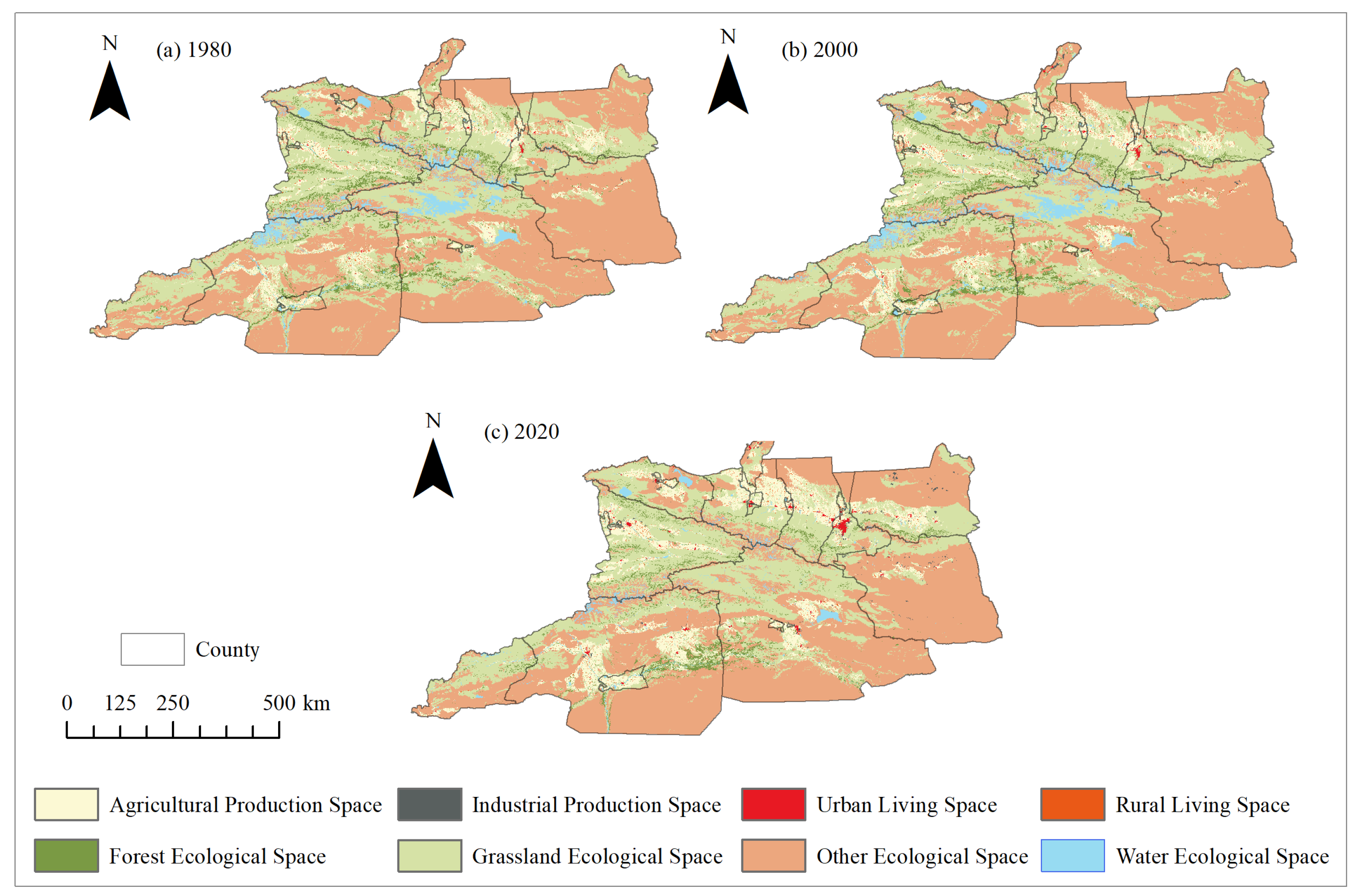
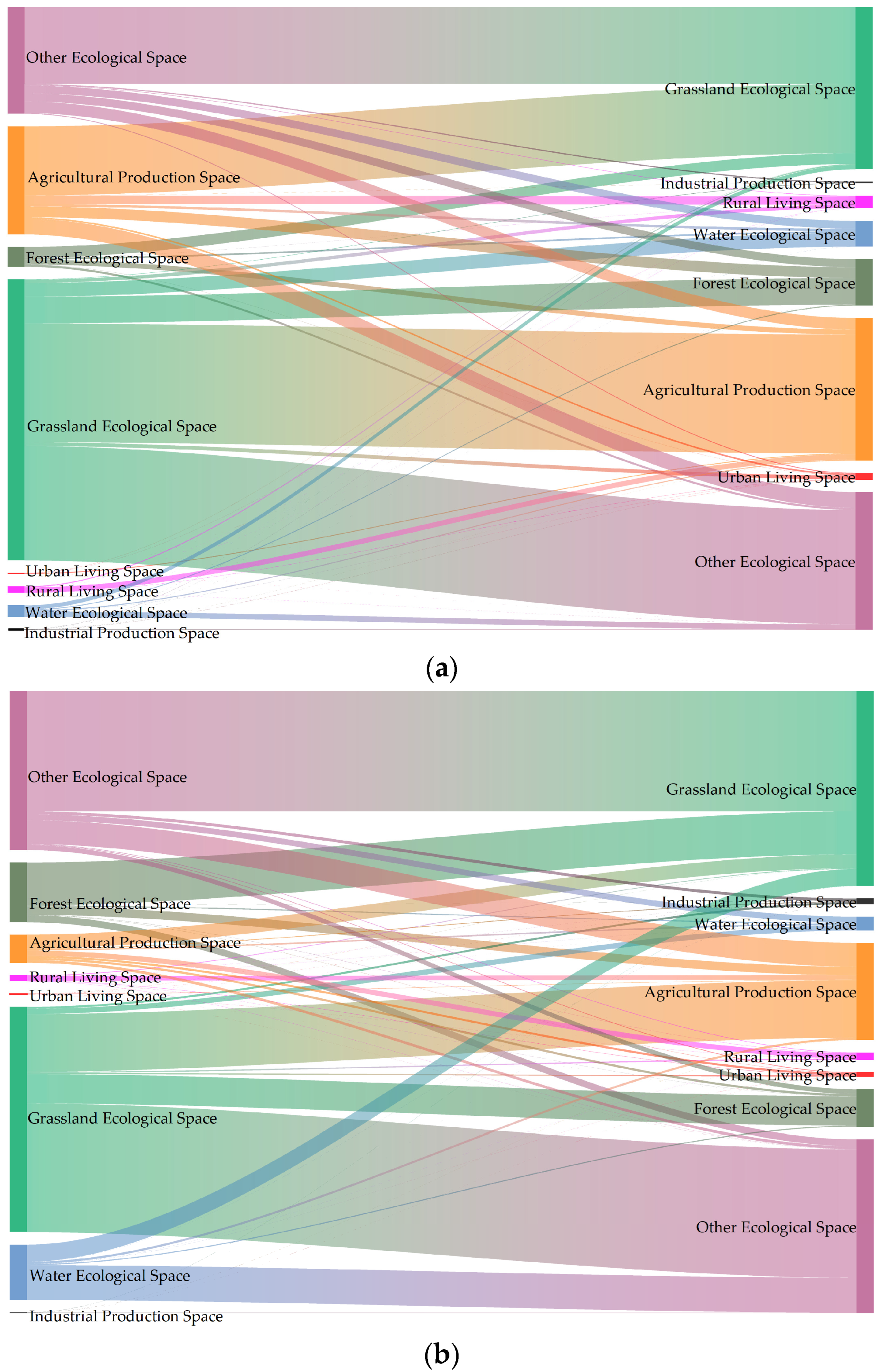
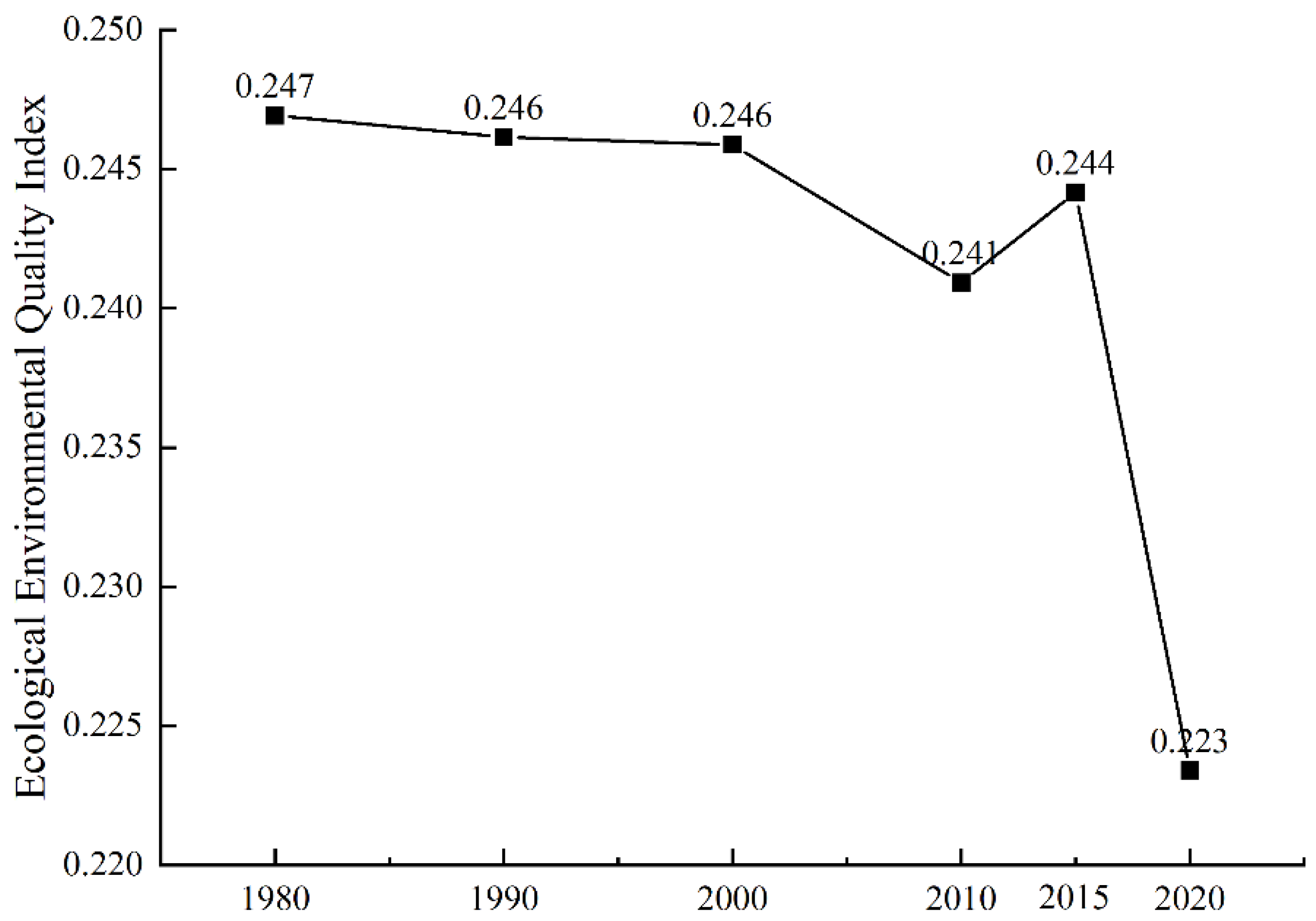



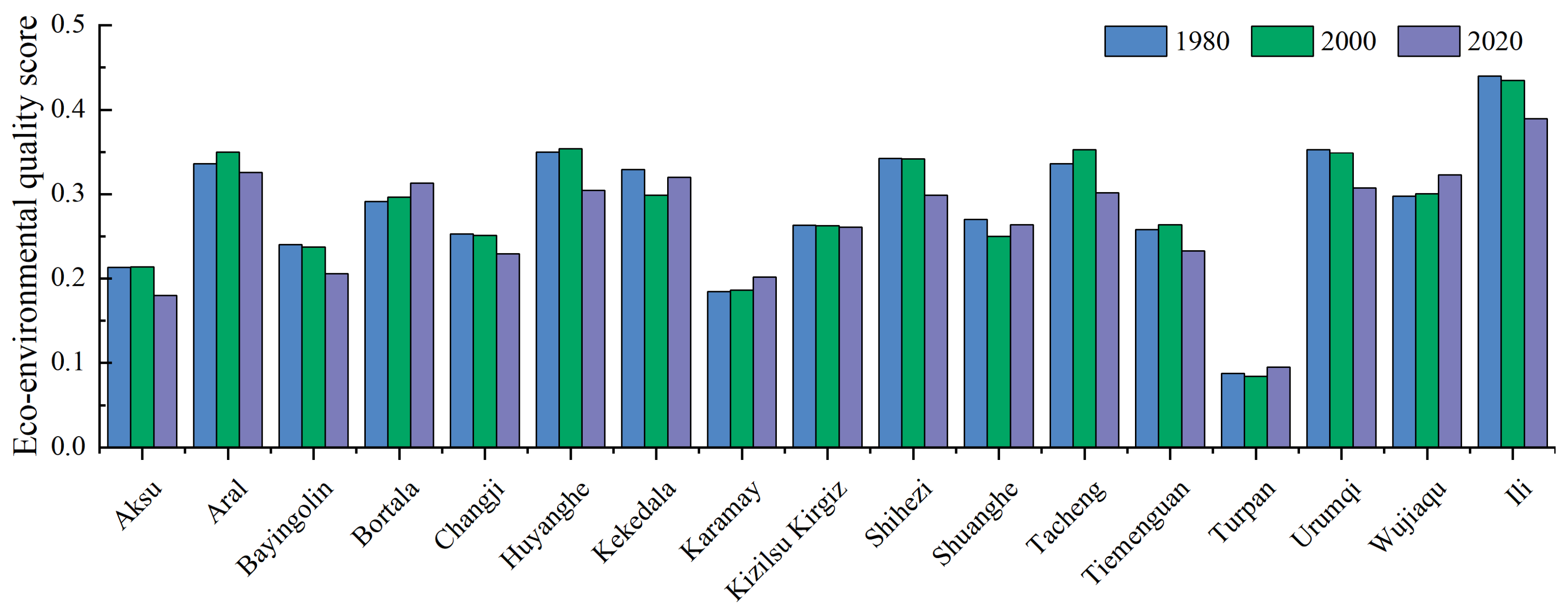
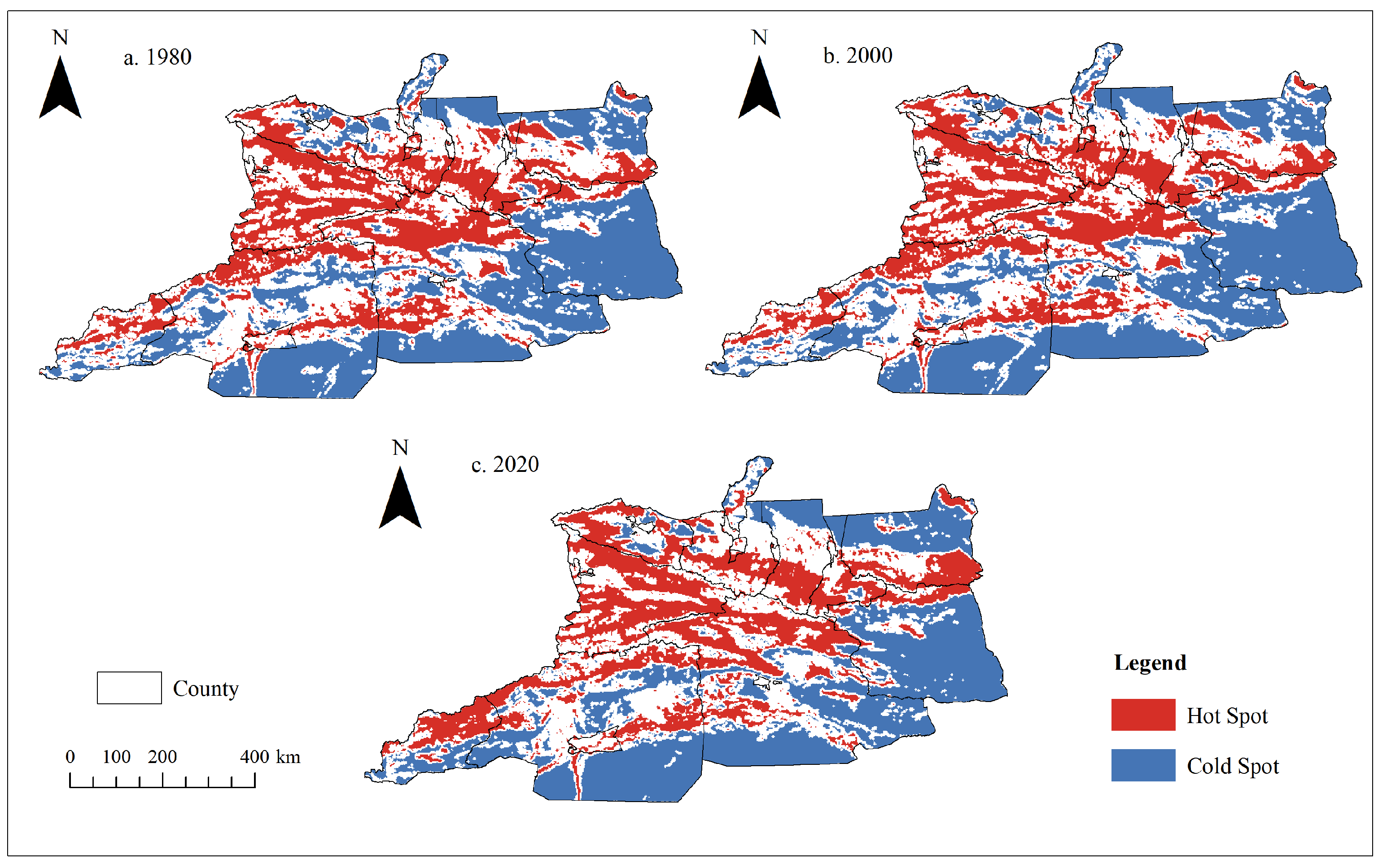
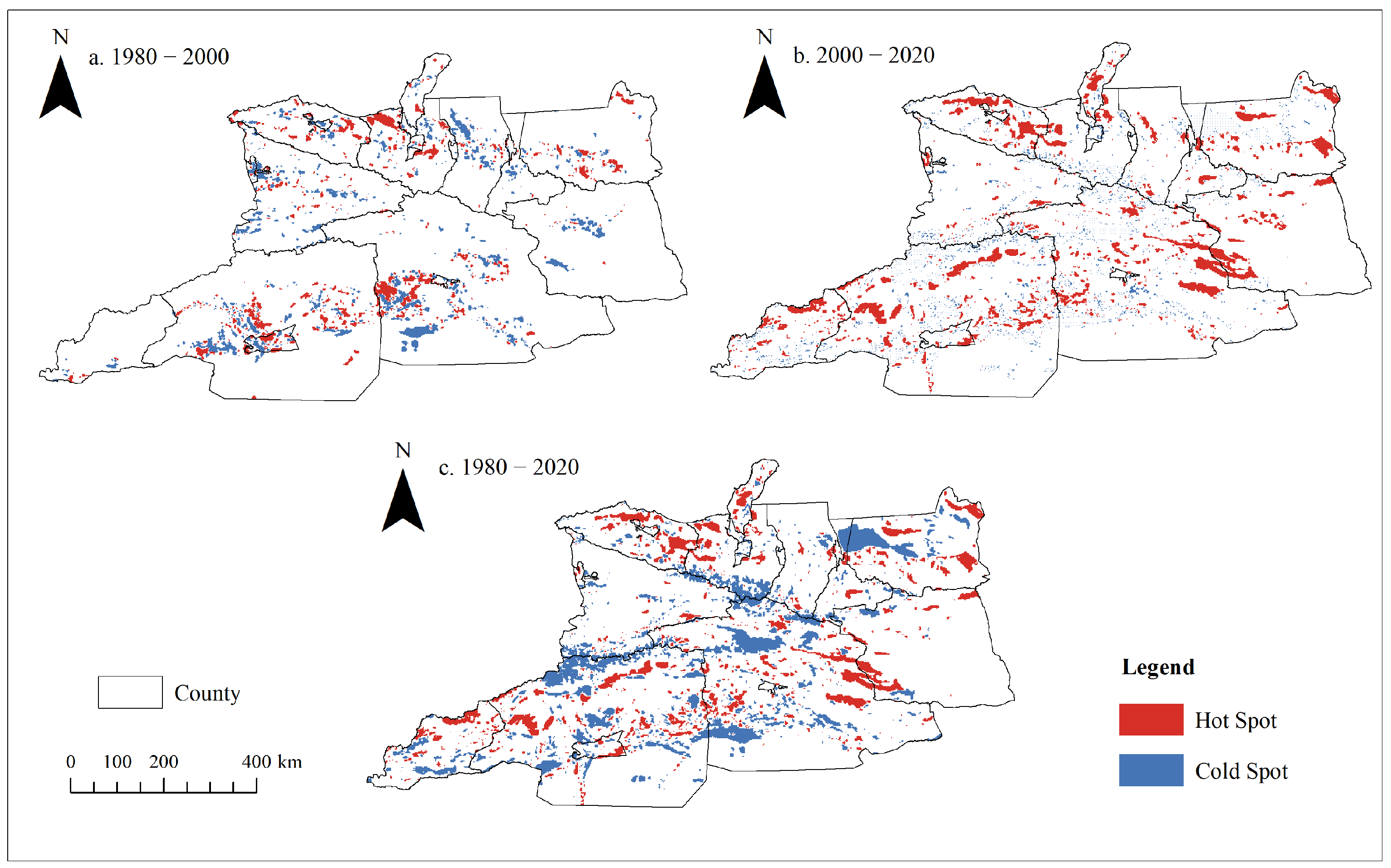
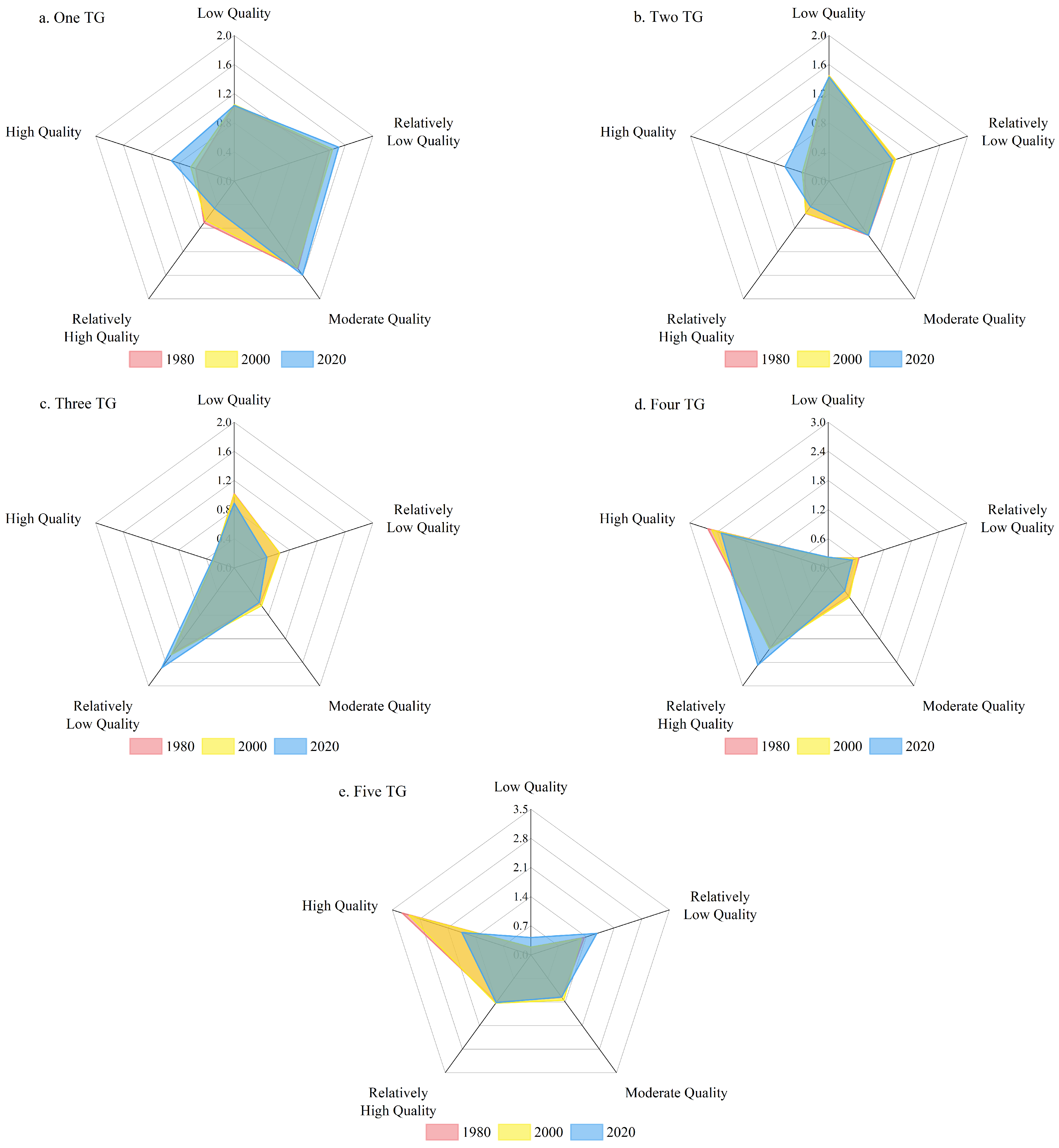

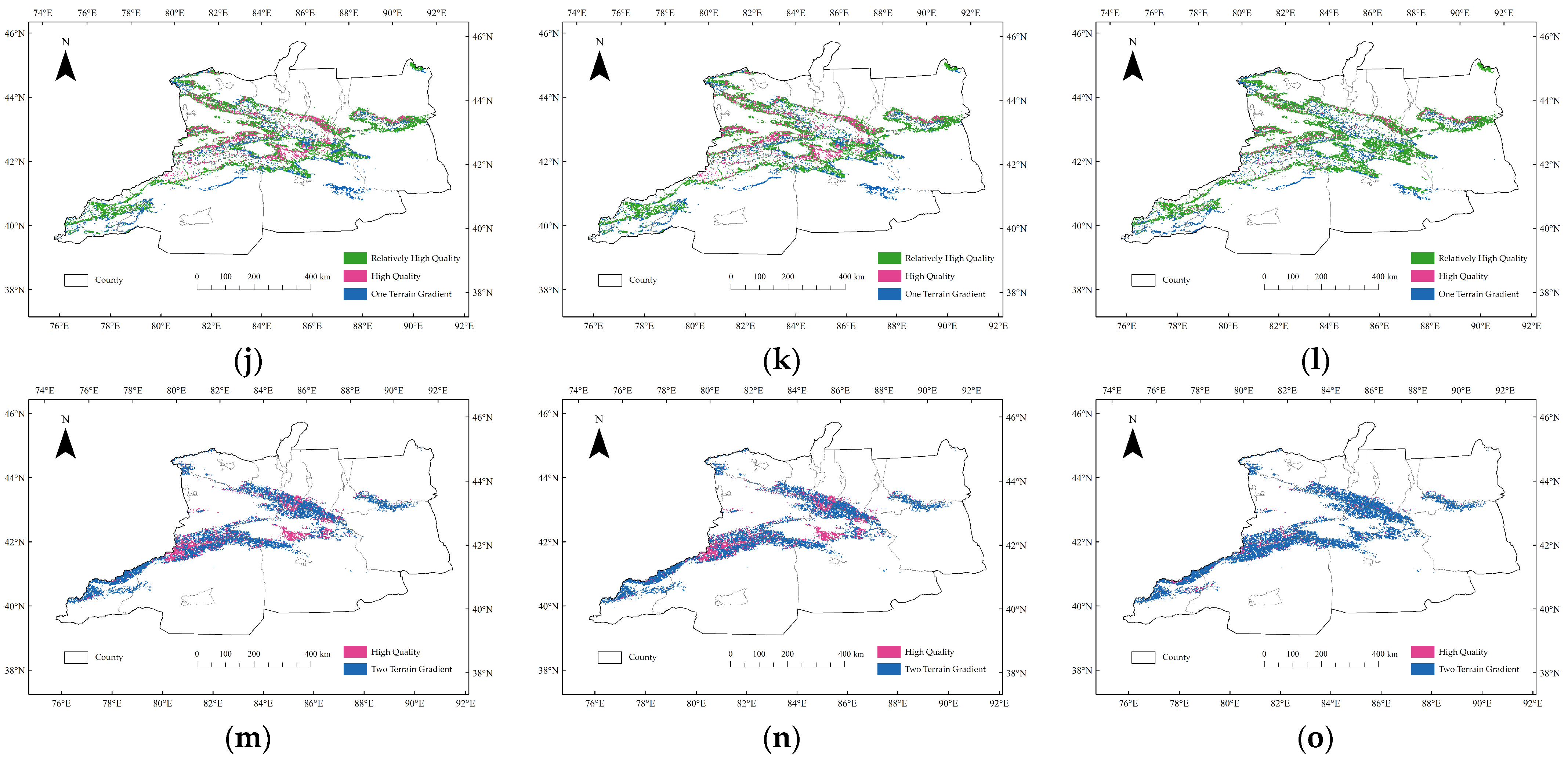
| Classification of P-L-E Spaces | Secondary Classification of the Land Use | EEQ Index | |
|---|---|---|---|
| Primary Classification | Secondary Classification | ||
| Production Space | Agricultural Production Space | Paddy Field, Dryland | 0.25 |
| Industrial Production Space | Industrial and Mining, Transportation Construction Land | 0.15 | |
| Living Space | Urban Living Space | Urban Land | 0.2 |
| Rural Living Space | Rural Residential Areas | 0.2 | |
| Ecological Space | Forest Ecological Space | Sparse Forest Land, Shrub Forest Land, Forested Land, Other Forest Land | 0.766 |
| Grassland Ecological Space | Low Coverage Grassland, Medium Coverage Grassland, High Coverage Grassland | 0.448 | |
| Water Ecological Space | River Channels, Lakes, Reservoirs, Ponds, Permanent Glaciers and Snowfields, Beaches | 0.814 | |
| Other Ecological Space | Wetlands, Bare Rock and Gravel, Gobi Desert, Sandy Land, Beaches, Saline-Alkaline Land, Bare Soil, High Cold Desert | 0.019 | |
| Primary Classification | Secondary Classification | Area (km2) | Change (km2) | Dynamism (%) | ||||
|---|---|---|---|---|---|---|---|---|
| 1980 | 2000 | 2020 | S80–00 | S00–20 | K80–00 | K00–20 | ||
| Production Space | Agricultural Production Space | 36,152 | 38,218 | 57,748 | 2066 | 19,530 | 5.71 | 51.10 |
| Industrial Production Space | 224 | 295 | 1711 | 71 | 1416 | 31.69 | 480 | |
| Living Space | Urban Living Space | 36,376 | 38,513 | 59,459 | 2137 | 20,946 | 5.87 | 54.38 |
| Rural Living Space | 461 | 799 | 1885 | 338 | 1086 | 73.31 | 135.91 | |
| Ecological Space | Forest Ecological Space | 1672 | 2038 | 2393 | 366 | 355 | 21.88 | 17.41 |
| Grassland Ecological Space | 2133 | 2837 | 4278 | 704 | 1441 | 33.00 | 50.79 | |
| Water Ecological Space | 20,877 | 22,476 | 16,146 | 1599 | −6330 | 7.65 | −28.16 | |
| Other Ecological Space | 207,034 | 199,845 | 191,395 | −7189 | −8450 | −3.47 | −4.22 | |
| Ecological Environment Quality | 1980 | 2000 | 2020 | ||||
|---|---|---|---|---|---|---|---|
| Number of Grid Cells | Proportion | Number of Grid Cells | Proportion | Number of Grid Cells | Proportion | ||
| Low-quality | 0.00–0.10 | 61,015 | 42.49% | 61,508 | 42.84% | 63,745 | 44.39% |
| Relatively low-quality | 0.10–0.25 | 13,356 | 9.30% | 14,173 | 9.87% | 17,842 | 12.43% |
| Moderate-quality | 0.25–0.40 | 18,558 | 12.92% | 17,551 | 12.22% | 17,088 | 11.90% |
| Relatively high-quality | 0.40–0.55 | 40,218 | 28.01% | 39,416 | 27.45% | 39,505 | 27.51% |
| High-quality | 0.55–1.00 | 10,443 | 7.28% | 10,942 | 7.62% | 5410 | 3.77% |
Disclaimer/Publisher’s Note: The statements, opinions and data contained in all publications are solely those of the individual author(s) and contributor(s) and not of MDPI and/or the editor(s). MDPI and/or the editor(s) disclaim responsibility for any injury to people or property resulting from any ideas, methods, instructions or products referred to in the content. |
© 2024 by the authors. Licensee MDPI, Basel, Switzerland. This article is an open access article distributed under the terms and conditions of the Creative Commons Attribution (CC BY) license (https://creativecommons.org/licenses/by/4.0/).
Share and Cite
Yi, M.; Yan, Q.; Li, K.; Ma, X.; Li, G.; Wu, Z.; Pan, Q.; Chen, X. The Ecological Environmental Effects and Topographic Gradient Analysis of Transformation in the Production–Living–Ecological Spaces in the Northern Slope of the Tianshan Mountains. Land 2024, 13, 1170. https://doi.org/10.3390/land13081170
Yi M, Yan Q, Li K, Ma X, Li G, Wu Z, Pan Q, Chen X. The Ecological Environmental Effects and Topographic Gradient Analysis of Transformation in the Production–Living–Ecological Spaces in the Northern Slope of the Tianshan Mountains. Land. 2024; 13(8):1170. https://doi.org/10.3390/land13081170
Chicago/Turabian StyleYi, Minghao, Qingwu Yan, Keqi Li, Xiaosong Ma, Guie Li, Zihao Wu, Qinke Pan, and Xingshan Chen. 2024. "The Ecological Environmental Effects and Topographic Gradient Analysis of Transformation in the Production–Living–Ecological Spaces in the Northern Slope of the Tianshan Mountains" Land 13, no. 8: 1170. https://doi.org/10.3390/land13081170
APA StyleYi, M., Yan, Q., Li, K., Ma, X., Li, G., Wu, Z., Pan, Q., & Chen, X. (2024). The Ecological Environmental Effects and Topographic Gradient Analysis of Transformation in the Production–Living–Ecological Spaces in the Northern Slope of the Tianshan Mountains. Land, 13(8), 1170. https://doi.org/10.3390/land13081170






